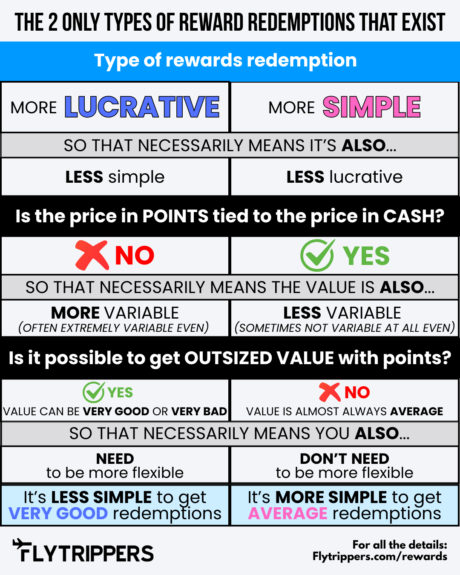We’re revamping our entire travel rewards section to make it the best possible. In the meantime, one of the most frequently asked questions that **isn’t** in our summary infographic that has all the basic answers is about the different redemption options for every travel rewards program.
We have a guide with all your reward redemption options for 13 reward programs that are popular with Canadian travelers.
To help you better understand the options, I present you this very important teaser on the 7 main sub-types of reward redemption options.
We’ll soon have a ton of more detailed content — and free webinars — but this is an excellent and useful primer in the meantime. Sign up for our free newsletter specifically for travel rewards to receive everything, including plenty of videos.
Here are the 7 main sub-types of how redemption options work.
The very basics of reward redemptions
Every reward program is different and offers its own rewards, which we call a currency because it’s more generic (sometimes rewards are called points, miles, dollars, cash back, etc.). Each currency works according to its program’s rules.
The most basic concept is that while all reward currencies are different, almost all currencies give you multiple different redemption options, and the value of a currency is almost always different for each redemption option.
That is why THE most important thing, which is in our must-read infographic summary by the way, is to always use your rewards for travel.
It always gives you more value (or **almost** always: there are a few rare exceptions where using rewards for something other than trips gives the **same** value, and we’ll get back to that).
For example, 1 Aeroplan point can easily be worth 3¢ for flights, but it’s often only worth 0.65¢ for merchandise. That’s almost 5 times more value! So, in this teaser, I cover only travel redemptions. Because you should never redeem points for anything else!!!
But even for travel, there are still many different redemption options in one single rewards program. Obviously, they all work differently and can all offer different values.
For example, 1 Amex point or 1 RBC Avion point can easily be worth 3¢ for flights, but almost everyone uses them at a value of 1¢ for flights, unfortunately.
You can read the basics about rewards value and concrete examples of why you should use rewards for trips and not for any other junk (if you don’t mind my wording), as so many people sadly do, because they just don’t know. It’s normal not to know, but if you want to learn, we’ll help you.
The 2 types of redemption options that exist
Before you understand the 7 sub-types, let me remind you of the 2 types.
There are many reward redemption options, but for each of these options, the way it works is always 1 of only 2 types of ways that exist.
The 2 types are very different from each other:
- More lucrative
- More simple
Infographic that summarizes the 2 types

Here’s the text version with a bit more information and a concrete example of the same flight booked with both types of point redemption option.
More LUCRATIVE type
Rewards redemption options of the more lucrative type are necessarily less simple.
It’s less simple because the value of rewards varies more (often extremely variable) depending on the specific trip you choose. And because there are almost always more restrictions, too.
It’s more lucrative because the value can be higher and outsized. It can be very good (or very bad, too). You can get trips that are expensive in cash for a much lower equivalent price in points.
In short… it’s less simple to find a points redemption that gives you a very good value, and you need to be more flexible. But at least it can be more lucrative if you want to save more money; it can easily give you 5 times more value!!!
More SIMPLE type
Rewards redemption options of the more simple type are necessarily less lucrative.
It’s more simple because the value of rewards varies less (often not at all variable) depending on the specific trip you choose. And because there are almost always less restrictions, too.
It’s less lucrative because the value cannot be higher and outsized. It will almost always be average (never very good). You cannot get trips that are expensive in cash for a much lower equivalent price in points.
In short… it’s more simple to find a points redemption that gives you an average value, and you don’t need to be more flexible. But it absolutely cannot be more lucrative if you want to save more money; it gives you the lowest value by far!!!
Points of the more LUCRATIVE type — 4 sub-types of redemption options
Here are the 4 main sub-types for points of the more lucrative type.
1. Specific flights in premium cabins with airline price charts
It’s always what gives the best value of all the options. Because business-class and first-class flights cost so much more than economy class in cash, but the difference isn’t as great in points.
Concrete example
For 54,000 RBC Avion points (transferred to Avios points), I got a 12-hour flight in the world’s best business class… worth almost $4000.
If you have RBC Avion points (like with the RBC Avion Visa Infinite Card), there’s a 30% transfer bonus usually offered every year. So 54,000 RBC Avion points becomes 70,000 Avios points. If not, American Express points are also transferable 1 to 1 to Avios — or to Aeroplan, a program that’s even better for business class (my 13-hour flight in a great business class cost me 75,000 points instead of $4000+).
How it works
There is a price chart that dictates the guaranteed fixed amount of points that each flight costs.
As the number of points required is limited, necessarily the number of seats available is limited too. This is what allows for unlimited value: yes, the value is unlimited, because the price in points remains the same regardless of the price in cash.
Value of the points
It’s completely variable. It depends on the flight and the date of the flight. Because it depends on the price of the flight in points (dictated by the price chart) and the price of the flight in cash (dictated by the market).
But for premium cabin flights, if you find availability at the price on the price chart, it almost always gives excellent value!
Restrictions
To find available seats, you need to be much more flexible than in economy class, because the value is so much higher! So you need to be flexible on dates and on the precise routing… or book very far in advance or very last minute.
Available routes are obviously very limited too: only those of the airline and its partner airlines.
This is the most restrictive sub-type, which is why it’s the one that can give you the most value!
2. Specific flights in economy class with airline price charts
This is what gives the best value in economy class. Because it’s the same principle of unlimited value, even if it’s obviously going to be lower.
Concrete example
For 6,000 Avios points, I got a last-minute flight that was worth $747. For 25,000 Aeroplan points, I got a roundtrip flight with 2 destinations in Central America that was worth $1000.
It’s not rocket science at all if you want points that give you the best value: you need Aeroplan points, Avios points, Amex points, or RBC Avion points.
How it works
There is a price chart that dictates the guaranteed fixed amount of points that each flight costs.
As the number of points required is limited, necessarily the number of seats available is limited too. This is what allows for unlimited value: yes, the value is unlimited, because the price in points remains the same regardless of the price in cash.
Value of the points
It’s completely variable. It depends on the flight and the date of the flight. Because it depends on the price of the flight in points (dictated by the price chart) and the price of the flight in cash (dictated by the market).
Sometimes the value is excellent, sometimes it’s NOT! It all depends! It’s like that for economy class flights with points of the more lucrative type. This option is especially good for flights that are expensive in cash.
Restrictions
Finding available seats still requires you to be flexible, either on the dates, the precise routing, or by booking well in advance.
Available routes are obviously very limited too: only those of the airline and its partner airlines.
3. Any flights with bank price charts
It’s an excellent option for those who want more flexibility. Because it works with all airlines and all seats are available.
Concrete example
For 17,500 RBC Avion points, I got a last-minute flight to Florida on New Year’s Eve that was worth $500.
Only 3 bank rewards programs offer this option: American Express, RBC Avion, and CIBC Aventura (not as good).
How it works
There is a price chart that dictates the guaranteed fixed amount of points that each flight costs (or a price range for CIBC Aventura).
But as the number of seats available is not limited, the value itself is necessarily limited: the table includes a maximum price for the ticket’s base fare.
Value of the points
It’s completely variable but with a maximum value due to the maximum ticket price. It depends on the flight and the date of the flight. Because it depends on the price of the flight in points (dictated by the price chart) and the price of the flight in cash (dictated by the market).
Sometimes the value is excellent, sometimes it’s NOT! It all depends! It’s like that for economy class flights with points of the more lucrative type. This option is especially good for flights that are expensive in cash.
Restrictions
You have to book on the program’s website, so smaller airlines may not be offered. But other than that, it’s not very restrictive.
4. Specific hotels with hotel chain price charts
It’s the most interesting option for the accommodations aspect.
Concrete example
With 60,000 Marriott Bonvoy points, I had a wonderful stay that was worth thousands of dollars in a luxury hotel in the Himalayas.
The only hotel rewards program easily accessible to Canadians is Marriott Bonvoy. The Marriott Bonvoy Amex Card happens to be the only card that is for all travelers, without exceptions.
How it works
There is a price chart that dictates the guaranteed fixed amount of points that each hotel costs (or a hidden price chart for Marriott Bonvoy).
Value of the points
It’s completely variable. It depends on the hotel and the date of the stay. Because it depends on the price of the hotel in points (dictated by the price chart) and the price of the hotel in cash (dictated by the market).
Sometimes the value is excellent, sometimes it’s NOT! It all depends! It’s like that for hotels with points of the more lucrative type. This option is especially good for hotels that are expensive in cash.
Restrictions
Hotel redemptions have way fewer restrictions than flights, as the availability is not limited.
Basically, the only restriction is having to choose among that hotel chain’s properties.
Points of the more SIMPLE type — 3 sub-types of redemption options
Here are the 3 main sub-types for points of the more simple type.
1. Any trips booked on any website at a fixed value
That’s the simplest thing possible. Because it gives you the absolute flexibility to book anywhere, and you don’t have to choose your trips carefully.
Concrete example
With 50,000 Scene+ points, I got a flight worth $500.
You can get 77,500 Scene+ points with the Scotiabank Gold American Express Card‘s welcome bonus, one of the best offers for simple points right now.
How it works
You can book any trip on any site and use the points to “erase” the expense on the program website afterward.
Value of the points
It’s completely fixed. The points always have the same value.
Restrictions
None.
2. Any trips booked on the program website at a fixed value
That’s what’s almost as easy. Because you don’t have to choose your trips carefully, but you do have to book on the rewards program website.
Concrete example
For 100,000 TD Rewards points, I got a hotel stay that was worth $500.
You can get 165,000 TD Rewards points with the TD First Class Travel Visa Infinite Card‘s welcome bonus, the best offer for simple points right now.
Even the WestJet Rewards program has a fixed value: the 525 WestJet dollars you get with the WestJet RBC World Elite Mastercard give you a simple discount of $525 on a WestJet flight.
How it works
You can book any trip on the rewards program website.
Value of the points
It’s completely fixed. The points always have the same value.
Restrictions
With bank points, there’s very little restriction. Almost all flights and hotels are available on their websites, but not 100% of the options. And usually the price is the same on their websites, but not 100% of the time.
And with airline and hotel chain points, you’re limited to their own flights and hotels, but there are no major restrictions.
3. Any trips booked on the program website at a variable value
It’s a simple mechanism, but a little less so. Because even if the value is generally tied to the price in cash, it’s not fixed.
Concrete example
For 1,000 AIR MILES Miles, I got a rental car that was worth $120, thanks to the BMO AIR MILES World Elite MasterCard.
Even Aeroplan points allow this option, but only for flights on Air Canada (not on partners). All seats are available at a relatively stable value.
How it works
You can book any trip on the rewards program website.
Value of the points
It’s random and not transparent. There is no price chart or established value.
The points therefore have a variable value, but it doesn’t vary extremely. So it’s always pretty similar no matter the trip chosen.
Restrictions
With bank points, there’s very little restriction. Almost all flights and hotels are available on their websites, but not 100% of the options. And usually the price is the same on their websites, but not 100% of the time.
And with airline and hotel chain points, you’re limited to their own flights and hotels, but there are no major restrictions.
Learning how to travel for less
Join over 100,000 savvy Canadian travelers who already receive Flytrippers’ free newsletter so we can help you travel for less — including thanks to the wonderful world of travel rewards!
Summary
The different redemption options for travel rewards always work according to the 2 types that exist, more lucrative or more simple. All the sub-types work quite differently in terms of logistics, restrictions, and value.
What would you like to know about travel rewards redemption options? Tell us in the comments below.
See the flight deals we spot: Cheap flights
Discover free travel with rewards: Travel rewards
Explore awesome destinations: Travel inspiration
Learn pro tricks: Travel tips
Featured image: Maldives (photo credit: Hoodh Ahmed)




